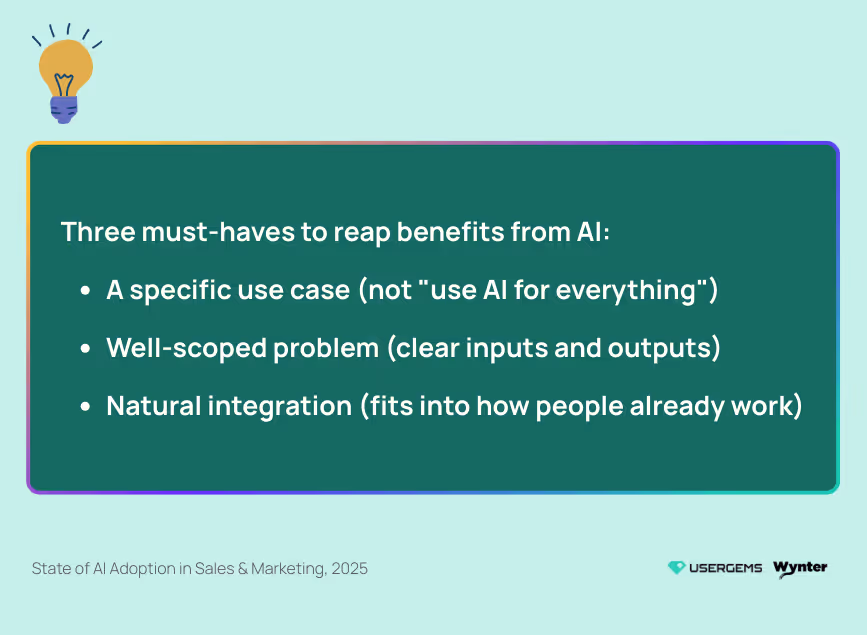We Asked 100 Revenue Leaders About AI.
Here’s What They’re Not Telling You

The reality check on AI adoption
Every sales and marketing leader is talking about AI. But what's actually happening on the ground?
Using Wynter, we surveyed 100+ B2B SaaS marketing and sales leaders to cut through the hype and understand the real state of AI adoption.
We wanted to know: What's working? What's broken? And where are teams placing their bets for the future?
The findings challenge the narrative that AI will automate everything. Instead, they reveal a more nuanced reality, one where success comes from knowing not just where to use AI, but where to keep humans firmly in control.
This report unpacks the lessons learned, barriers faced, and the emerging shift towards "human-first AI" that's shaping how teams actually work
Part 1: AI reality check - Few wins, many lessons
When we asked leaders to describe their team's current success level with AI adoption, the results painted a picture of an industry caught between promise and reality:
AI adoption is widespread, yet clear returns remain uncommon.
Only 7% of teams report measurable ROI, while nearly half (45%) see limited success with uncertain value. Meaningful results, though achievable, are not yet typical.
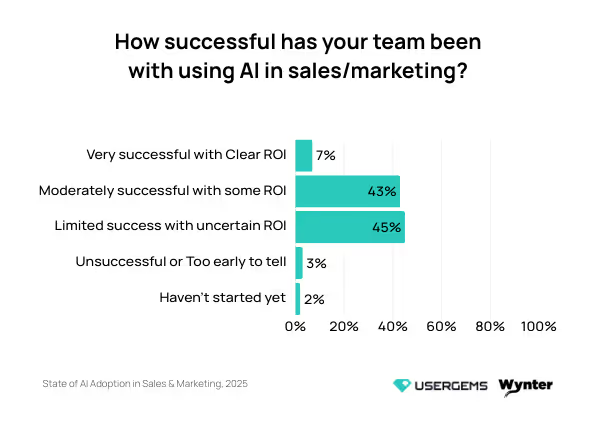

What's interesting is that the biggest lessons learned in AI adoption are overwhelmingly human and strategic, rather than technological.
Marketing and sales leaders report they previously approached AI tools as an immediate fix-all solution rather than recognizing that it requires a more thoughtful approach.
So, we asked leaders to share their biggest lessons (both good and bad) from their AI adoption attempts. Their responses revealed five key lessons:
- AI is not plug-and-play
- Need clean data & good prompts
- Need team buy-in
- Important to scope it right
- Require a mindset shift
Your AI rollout will fail without team buy-in

Nearly a third of respondents highlighted team resistance as their main challenge in AI adoption.
The core concern is clear: people don’t want to be replaced; they want AI to act as an assistant.
The biggest barriers are the emotional responses, ranging from job security fears to loss of creative control and brand voice.
Real success means facing those concerns head-on. That includes giving teams time to learn, space to adapt, and a chance to find personal value in using AI, rather than pushing adoption from the top down.
Most importantly, leaders need to position AI as a co-pilot that enhances their work, and not a replacement that threatens their value.
"AI can be super intimidating for team members to adopt. They know they need it, but they are worried it will replace them if they prove how effective it is. This has been the biggest hurdle." - Director of Demand Generation, 1001-5000 employees, SaaS/software
"At first, I was nervous about using AI, especially as a content marketer. There was the fear of the unknown and whether it would replace my job." - Director Demand Generation & Content Marketing, 501-1000 employees, SaaS/software
AI isn’t plug-and-play.
It needs training.
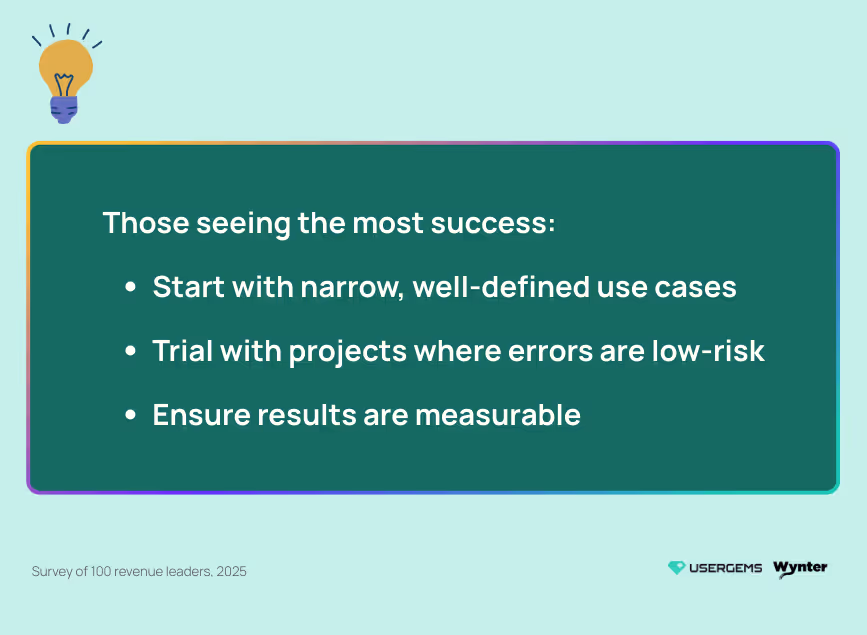
Although many want plug-and-play solutions, the reality is that success requires team effort upfront, and from all levels.
Leaders told us AI adoption is more of an operational transformation. The tools require setup, training, and continuous optimization to deliver maximum value.
Those seeing the most success:
- Start with narrow, well-defined use cases
- Trial with projects where errors are low-risk
- Ensure results are measurable
Above all, team leaders must stop expecting instant automation and start treating AI like a team member, one that needs ongoing coaching, oversight, and room to grow.
"The setup and training of an AI tool is key. It takes time to train a system to your company's needs and goals. You have to be invested for the long term and not expect results overnight. The challenge is always stakeholder education and getting buy-in." - Demand Generation Director, 501-1000 employees, SaaS/software
"Each AI tool I've run into has a 'training' period that takes longer than expected to get up and running. I've learned that people tend to underestimate how long to get things to be working fully under AI, so you don't provide bad experiences to users." - Head of Digital Marketing, 501-1000 employees, SaaS/software
"I've learned to absolutely trust the process and realize that you likely will not see results right away. There's trial and error with AI, but if you put the time and effort, I believe most companies will reap the benefits." - Director of Marketing, 201-500 employees, SaaS/software
Even when teams were on board, human oversight proved non-negotiable at many steps:
"AI still takes a lot of resources to get set up and running. It's forcing more general leaders to become operational experts. It's a fast learning curve we are on. I still think it requires a human eye and to be used in a co-pilot mode rather than fully automated when it comes to prospecting and outreach." - Marketing Director, 201-500 employees, SaaS/software
You need clean data (and good prompts)

We found that a quarter of AI implementation issues trace back to two things: messy data and bad prompts. Without updated, structured data and the skill to craft sharp prompts, leaders found their teams weren’t getting the most out of their tooling.
- Data quality is non-negotiable:
"Data quality is important for AI to work properly. CRM data, including validations and flows, needs to be structured in order for AI to deliver productivity improvements." - Senior Director of Revenue Operations, 1001-5000 employees, SaaS/software
- Good prompts make all the difference:
"I've learned that good prompts can mean all the difference when it comes to getting a desired outcome with AI tools. So, learning how to write good prompts helps with the efficiency of using the tools." - Demand Generation Director, 1001-5000 employees, SaaS/software
The ability to personalize prompts helps set clear expectations and deliver on-brand results, with outputs that actually sound like they’re coming from your team:
“We've had much more success with platforms that allow us to develop prompts that truly meet our needs and provide flexibility to provide whatever we need.” - Director Digital Marketing 1001-5000, SaaS/software
Three must-haves to reap the benefits from AI
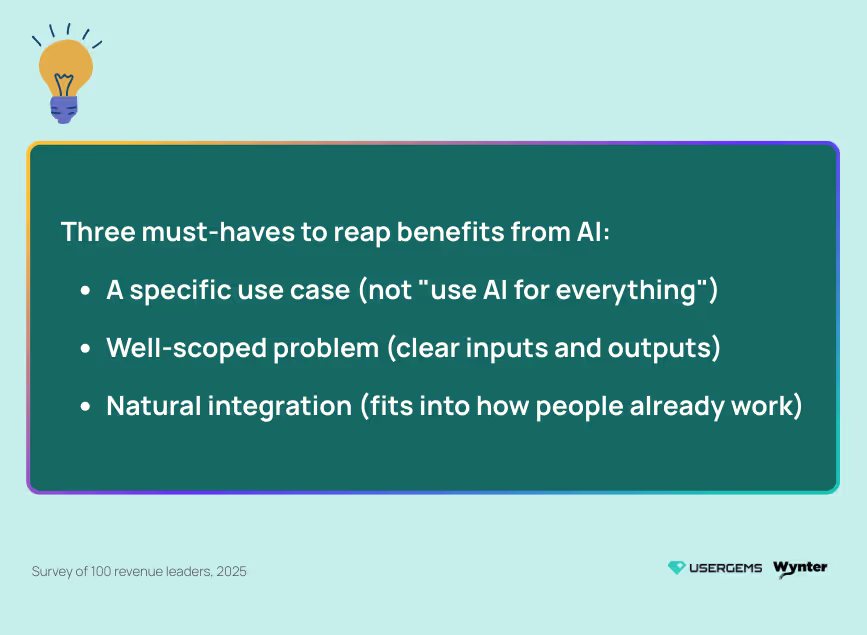
Across company sizes, our sample reported three levels of benefit when they adopt AI tools:
- Immediate: Tasks get done faster
- Secondary: There’s more time for strategic work
- Transformative: They’ve got the ability to tackle previously parked projects
"AI has helped to keep us focused on our strategy and ensure that all of our initiatives ladder up to support our objectives. It's been very useful for remembering small details and millions of ideas, sorting through it all and ensuring to connect the dots between initiatives for maximum impact." - Director of Demand Generation, 201-500 employees, SaaS/software
But actually saving time depends on these three must-haves:
- A specific use case (not "use AI for everything")
- Well-scoped problem (clear inputs and outputs)
- Natural integration (fits into how people already work)
Advice from leaders who still have hesitant team members?
"If your team is hesitant to adopt and implement AI, start small with redundant, manual tasks. Not everything needs to be big and splashy right away." - Senior Marketing Manager Community Growth, 5001-10000 employees, SaaS/software
Other marketing leaders are forging ahead; they’re finding efficiency wins in scalability and empowering their teams to go bigger and faster.
"The good - it can help with scale issues where it's tough to see the whole picture. Especially when dealing with an ABM approach." - Director of Enterprise Demand Generation Marketing, 5001-10000 employees, SaaS/software
"There are definitely areas that the AI has taken work off a human's plate that allows us to redirect our efforts to other areas to just go bigger, faster." - Head of Digital Marketing 501-1000 employees, SaaS/software
Part 2: The barriers holding teams back
Why AI still feels broken for most teams
When we asked leaders what's holding them back with AI. Their answers showed the problems often run deeper than just the tools themselves.
These numbers are a wake-up call:
- 62% said data trust is their #1 limitation.
- 50% admitted they don't really know what AI can do.
- And almost as many are fighting to connect AI tools to their existing systems.
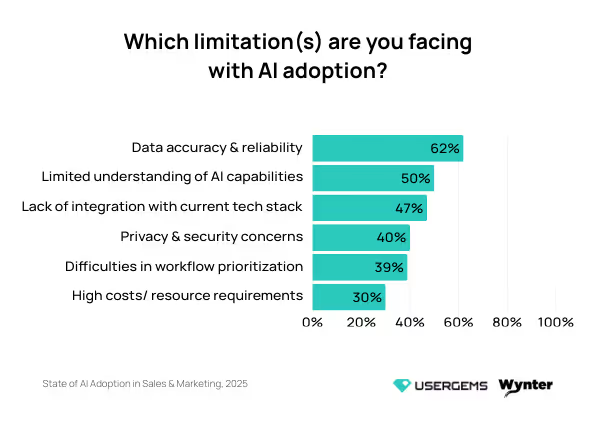
AI without data trust is dangerous
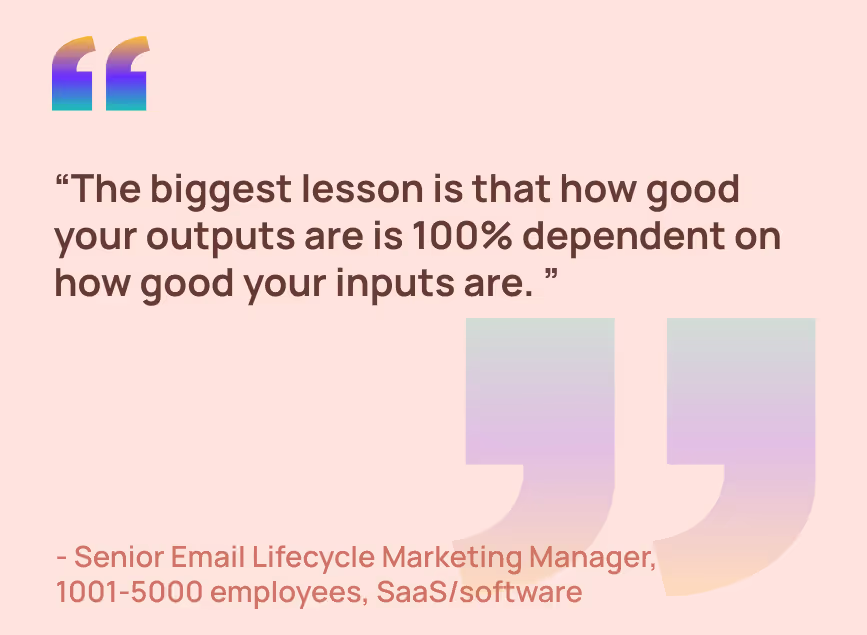
You can’t layer AI on top of noise. Bad data + AI = Spam cannons & bad decisions.
Some teams learned this lesson the hard way.
"The biggest lesson is that how good your outputs are is 100% dependent on how good your inputs are. Whether it's to ensure you have all the relevant data, APIs, background information, etc. The quality is based on how good it is." - Senior Email Lifecycle Marketing Manager 1001-5000 employees, SaaS/software
AI hallucination is also a major concern.
"Current solutions still require a lot of handholding. Even sophisticated AI solutions are still hallucinating and have to be checked by humans before they can be trusted.” - Director of Marketing, 1001-5000 employees, SaaS/software
“I work in an industry where its important to make accurate claims, or where we need to be sensitive about claims we're making because of competitive product and feature overlaps with some of our partners, and AI hasn't picked up on that level of nuance yet.” - Senior Portfolio Marketing Manager, 1001-5000 employees, SaaS/software
Until AI tools can guarantee accuracy, most output still requires human verification. Trust-but-verify and humans-in-the-loop are integral parts of most of AI workflows.
Lack of training and space to learn new skills

Teams need support that goes beyond the top-down mandate to use AI.
Nearly one in five teams (17%) are flying blind, saying they don't know the full capabilities of what their AI tools can actually do for them.
Even when leadership pushes for AI adoption, employees need time and space to learn new skills, catch up with the changes, and adapt their workflows:
"Even though leadership pushes the use of AI, they don't provide time for learning, or specific use cases." - Director of Integrated Marketing and Demand Generation ABM, 501-1000 employees, SaaS/software
"It's very helpful to create a learning journey to help people not only learn what and why, but also how to implement best practices and give people the opportunity, time and space to practice." - Director of Business Development 201-500 employees, SaaS/software
Lack of integrations
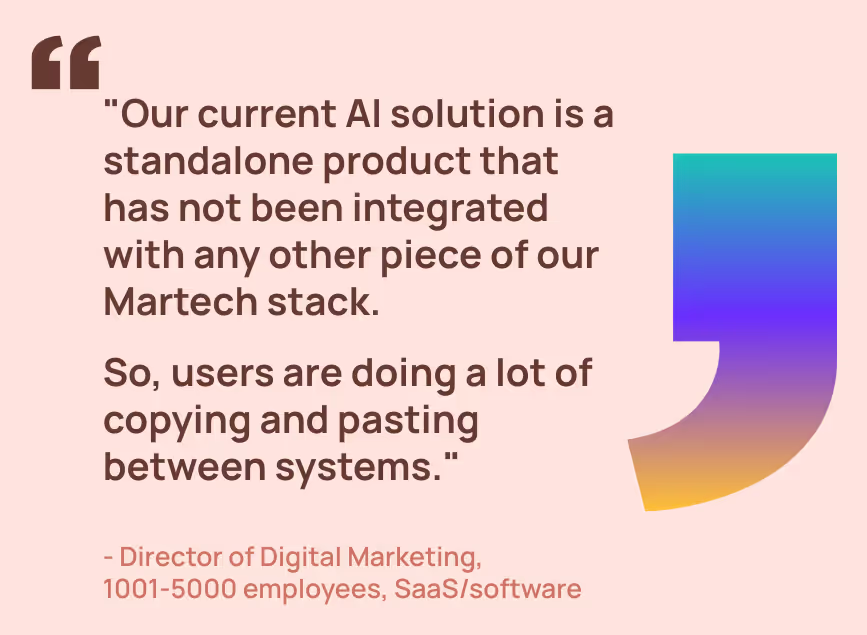
AI tools promise efficiency. But when your team has to spend time jumping between tools and making sure everything is in sync, AI tools can create as much work as they eliminate.
"One of the biggest gaps we've seen is integration. Many AI tools don't connect well with our existing tech stack, making it hard to embed them into real workflows. We also struggle with the lack of flexibility. Most solutions don't adapt to how marketing teams actually operate day to day." - Senior Marketing Manager, 501-1000 employees, SaaS/software
Teams are exhausted by:
- Copy-paste workarounds between systems
- Manual data transfers
- Disconnected insights that don't flow to where decisions get made
"Currently, our AI solution is a standalone product that has not been integrated with any other piece of our Martech stack. So, users are doing a lot of copying and pasting between systems. While it's saving time - and providing great intel for our marketers - there are so many more places we could be leveraging AI if our tech stack were better aligned." - Director of Digital Marketing, 1001-5000 employees, SaaS/software"
Part 3: 97% of teams plan to continue their AI investments
Despite the challenges we've covered, even teams struggling with AI adoption aren't giving up. 97% plan to maintain or increase their AI investments over the next 12-18 months.
It makes sense: They've already done the hard part: getting started, making mistakes, learning what works. Now they're ready to accelerate and be intentional about where they invest to achieve more results.
Investment priorities: Where teams are placing their bets

The majority are time-consuming tasks related to outbound and pipeline generation: Finding prospects, tracking buying signals, prioritizing accounts & contacts, writing personalized emails.
Sales and marketing leaders are looking for tools that help their team save time to focus on high-value tasks.
The human-AI balance: What should machines actually do?

We wanted to know exactly how teams see AI fitting into their daily work. Are there any specific tasks that should be fully human, fully AI, or somewhere in between?
Even though AI evolves more rapidly than anything we've seen before, these survey answers reveal how leaders perceive and trust AI's capabilities today.
AI search and GPT optimization: 40% of teams want AI to fully manage search optimization, while the other 57% want Human-in-the-loop.
Account and lead scoring: Similarly, 40% want AI to manage scoring and prioritization fully. This makes sense as scoring requires processing a large amount of data. But as this output impacts GTM decisions, 50% of other responses still want humans to review.
Forecasting: 72% want AI involved in forecasting, but only to assist. They want tools that surface insights, spot patterns, and highlight risks. It’s less “AI predicts the future,” and more “AI shows us what to pay attention to.”
Outbound and email personalization: Personal outreach remains firmly in human-AI partnership territory, with 84% requiring human touches on AI-generated messages.
The overall pattern? Even for the most AI-suitable tasks, many leaders still want humans involved in review, approval, and quality control.
Trust isn't quite there yet. As one sales leader put it:
"It's very early days. The trust I think we will have in AI to be more autonomous is coming but it's not fully here yet." - Global Director Sales Enablement, 501-1000 employees, SaaS/software
What tasks should stay human?

1. Creative work & brand voice (29%)
Nearly a third of leaders draw a hard line on creative work. They've tested AI for campaigns, storytelling, and design, and the results feel pretty average.
The problem: AI-generated content all sounds the same. Inboxes are drowning in generic, recycled content that nobody remembers. Some leaders refuse to add to the noise.
The reality: AI is most useful for brainstorming and first drafts, but final creative output needs human personality and strategic thinking.
"Right now, we are seeing an explosion of AI-generated content, which is bland and regurgitated. AI doesn't create original insights, it just re-words existing content." - Senior Marketing Manager, 10,000 employees, SaaS/software
"I think content should always remain human-driven. I think AI is useful for a first draft, but it needs to be treated as a draft. It still needs a human set of eyes to check for tone, brand voice, and accuracy." - Director Demand Generation, Content Marketing, 501-1000 employees, SaaS/software
"AI can brainstorm and assist with the ideation, but original, and emotional creative concepts usually come from a human experience." - Senior Demand Generation Manager, 501-1000, SaaS/software
2. Customer & buyer communication (21%)
Somewhat surprisingly, one in five leaders believe customer interactions should stay firmly in human hands. Their main reason is protecting customer relationships as they recognize the risk of one bad AI response undoing months of relationship building. So, they’d rather keep control over customer facing touchpoints.
The problem: To this group, AI-generated customer communications feel fake and can miss crucial nuances. These teams have experienced when AI has fumbled emotional context, misread the room, and felt too robotic.
The reality: Buyers can spot (bad) AI emails from a mile away, they can feel transactional when relationships need to feel personal. Plus, when clients reach out with detailed requests, they expect human expertise, not a chatbot response they could've gotten themselves.
“When a client reaches out for a detailed and nuanced request that only a human should respond with a level of expertise needed to show an understanding of the client's request. if the client could just use AI on their own, why come to us?” - Director of Mid Market Sales 201-500 employees, SaaS/software
“The actual sales process where people are talking to people will never be automated. It will always need that human element.” - Director Banking Services, 201-500 employees, SaaS/software
“In-person and phone outreach can never be replaced by AI. Human to human contact will always be the best way to forge relationships.” - Senior Digital Marketing Manager, 1001-5000 employees, SaaS/software
3. Relationship building (13%)
A further 13% refuse to let AI anywhere near relationship-building activities. They believe human trust, rapport, and connection drive B2B deals.
The problem: These leaders know AI can't read a room. It can miss emotional cues, can’t sense frustration and lacks the genuine empathy that builds trust. Leaders believe true relationship building is about understanding unspoken dynamics, which is something they’re yet to see AI re-create.
The reality: Real connections happen face-to-face: trade shows, conferences, coffee chats or even surprise gift boxes with handwritten notes. One team, after months of digital outreach dead ends, finally cracked a major account with a personalized gift. Those are the moments AI can’t replace.
"Relationship-focused activities should remain human-based to the fullest extent possible - so trade shows, events, webinars, etc." - VP of Global Field Marketing Business Development, 1001-5000 employees, SaaS/software
"Relationship management should always be handled by a human. While there can still be some automated outreach (like customer upsell nurture campaigns), humans should always be interacting at regular intervals to assess emotions, frustrations, etc." - Director of Marketing, 1001-5000 employees, SaaS/software
"1:1 coffee chats and calls. In-person experiences such as meetups and conferences. Anything where the goal is connection, really." - Senior Marketing Manager Community Growth, 5001-10,000 employees, SaaS/software
4. Strategic thinking & decision making (12%)
When it comes to setting vision and making big calls, 12% of teams say AI stays in the assistant role and should never be the sole decision-maker.
The problem: AI is great at spotting data patterns, but it doesn’t always understand the full picture. It can overlook organizational politics, market dynamics, and human factors that actually drive decisions. That’s why teams are open to AI supporting strategy tasks like forecasting, but not owning them. The data helps inform decisions, but judgment, context, and trade-offs still come from humans. Strategy needs more than numbers; it needs perspective.
The reality: Strategy requires understanding context that doesn't show up in dashboards. Budget allocations, channel priorities and brand-positioning decisions happen where data, culture and business instinct meet. The leaders we surveyed believe humans are best at weighing the trade-offs.
"Strategic decisions - AI can surface data trends and suggestions, but deciding what to prioritize, where to invest, and how to adapt is human all day. Org politics, business prioritizes, macroeconomics isn't on a dashboard or output ever." - Senior Campaign Marketing Manager Demand Generation, 10,000 employees, SaaS/software
"High-level strategy and vision setting is a human job." - Director Global Integrated Demand, 201-500 employees, SaaS/software
"Strategic brand positioning: Defining a brand's essence, voice, and long-term positioning requires a deep understanding of culture, emotion, market context, and human values. AI can assist with data and support, but final positioning needs to come from humans who have emotions." - Senior Demand Generation Manager, 501-1000 employees, SaaS/software
Teams have figured out that AI works best on repetitive, data-heavy tasks, while humans own the moments where trust, creativity, and judgment determine who makes the shortlist and wins the deal.
Part 4: What kinds of AI solutions do people actually want
Human-first AI solution
Human oversight built in:
- Humans stay in control: 36% expect AI to work as an assistant under human direction with clear approval workflows, override functions, and the ability to personalize suggestions. They don’t want anything to ship without human review.
- Brand voice matters: Teams want AI trained on their data and natural language patterns, with humans stepping in to shape outputs to match company tone and messaging.
- Augment, don't automate: Human-first AI should boost efficiency on subtasks while preserving meaningful human involvement in strategic decisions and quality control.
"I would expect AI solutions to either have human input and approval built into their workflow. Or at a conceptual level, the solution has been trained effectively by humans to act as human as possible." - Director of Marketing, 201-500 employees, SaaS/software
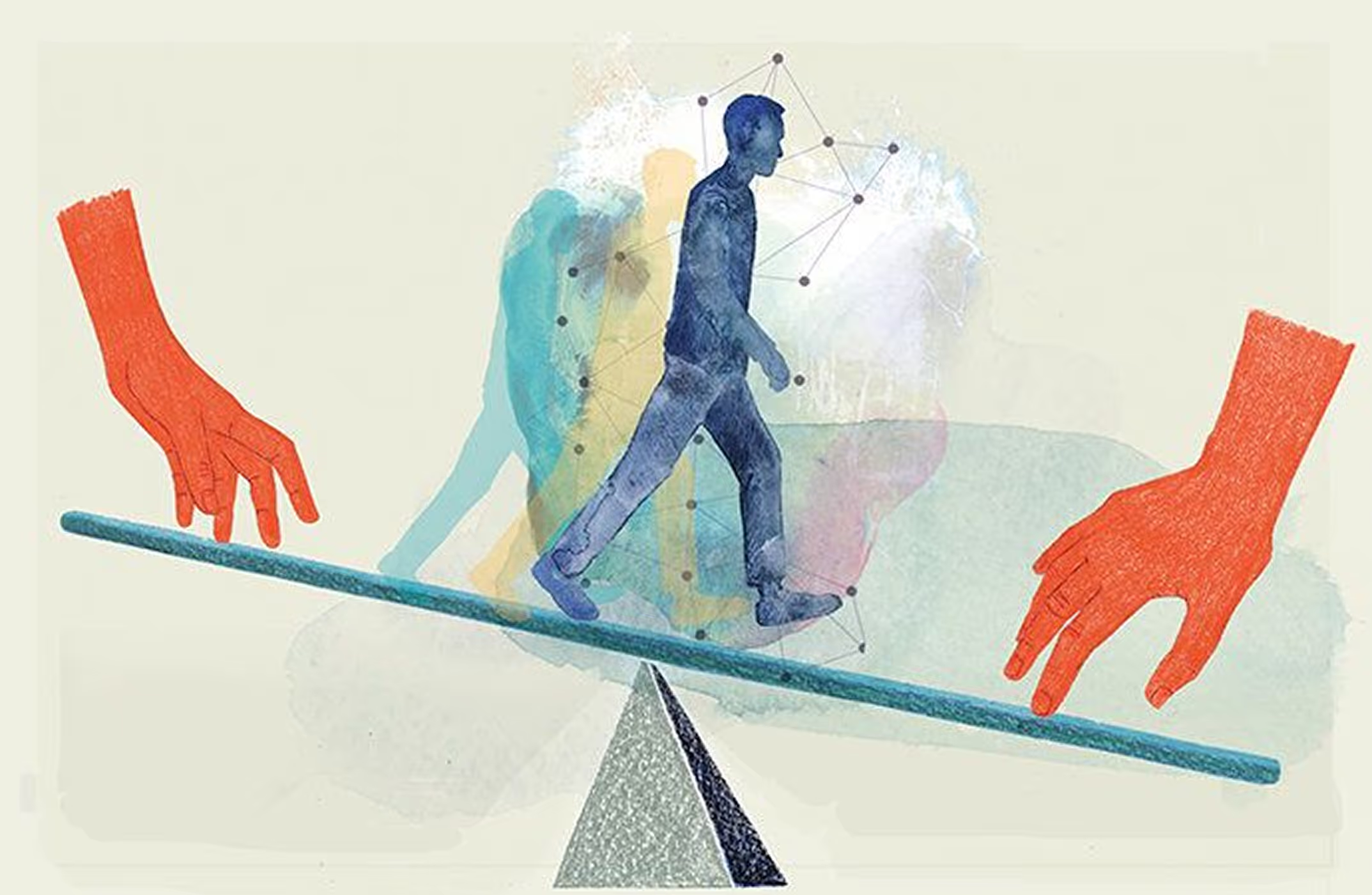

Empathy and context
- Feels human, not like a robot: 16% expect human-first AI to communicate with emotional nuance and organic language, no tone-deaf responses or robotic templates that scream "automated."
- Read the room: Teams want AI that spots buyer intent signals, understands cultural context, and makes nuanced deductions about prospect behavior.
- Adaptive and personal: The ideal AI learns each user's communication style over time, tailoring recommendations and outputs to match the brand’s natural voice.
"Taking into consideration human experience, needs, and limitations and not just the capabilities of the technology." - Senior Demand Generation Manager, 501-1000 employees, SaaS/software
"I would expect the tone of the AI to not feel robotic, to have EQ or emotional training to try and teach it subtle queues that humans give off, and kindness needs to be a first." - Director of Marketing Services and Operations, 201-500 employees, SaaS/software
"The ability to understand and read emotion would be the first. Then the ability to make deductions based on those emotions or responses that are not black and white." - Director of Marketing, 1001-5000 employees, SaaS/software
Co-pilot (not all automated)
- AI as team member, not replacement: 15% think human-first AI would help generate first drafts, research topics, and diagnose performance dips while humans make final calls and add strategic thinking.
- Flexible collaboration: Teams expect workflows where they can "choose their own adventure," with AI handling prep work and surfacing ideas while humans stay in control of decisions and creative direction.
- Trust through partnership: The ideal AI produces reliable, human-sounding output that teams can build on, no hallucinations, no robotic language, just solid communications that makes their jobs easier without replacing their expertise.
"It's more of an augmentation, where you aren't automating or taking the work away from people, instead you're arming them with AI capabilities to do more themselves." - Global Director of Sales Enablement, 501-1000 employees, SaaS/software
"An AI solution that is built for humans to operate, control, and it would generally be more complementary to augment a human's work vs replace it." - Senior Director of Demand Generation, 1001-5000 employees, SaaS/software
"An AI solution intended to amplify and accelerate what a human is doing rather than replace what they're doing." - Director of Lifecycle and Demand, 501-1000 employees, SaaS/software


Boost productivity and efficiency
- Handle the grunt work: 13% believe human-first AI would tackle time-draining tasks like data entry, note-taking and research so teams can focus on high-value creative and strategic work.
- Speed up expert tasks: Teams expect AI to analyze data faster, spot process gaps, and deliver insights with recommendations. This added efficiency makes them more powerful without replacing their judgment.
- Make teams "super-human": Their goal is for AI to help people juggle more responsibilities by being easy to integrate, automating routine workflows, and boosting productivity across the board.
“Something that enables humans to become "super-human" by giving them the power that AI can offer to extend their capabilities. For example, if you work in customer support, using a "human-first AI solution" would mean giving a rep the tools to answer and serve exponentially more clients without the same core skills.” - Director of Integrated Marketing, 201-500 employees, SaaS/software
“The ability to suggest gaps in the process. Best practices in the demo and follow-up. What are the best sellers doing and how does it compare to those that are struggling?” - Senior Director of Inbound Sales, 501-1000 employees, SaaS/software
The investment decision: Which types of AI vendors you'd choose?
Understanding what teams want from "human-first AI" is one thing. But are they actually willing to bet their budgets on it?
We asked teams to make a choice: When investing in new technology, would they lean toward AI-based solutions or stick with proven traditional tools?
Here’s what they told us:
Strongly prefer AI: Efficiency first
30% see clear, measurable benefits from AI adoption. They report saving hours on routine tasks, reducing costs through automation, and getting more done with the same headcount. For them, AI tools help teams test and iterate more quickly. They view AI adoption as essential to staying competitive.
“At this point, while we're not replacing roles with AI, the expectation is that AI will make all roles more productive and not finding ways to leverage it is not an option.” - Director of Digital Marketing, 1001-5000 employees, SaaS/software
“My company invested early in the utilization of AI for internal productivity and has had some excellent successes. I believe we are ahead of the game in this respect. I think we need to keep pushing the envelope in terms of investing in AI to continue building that differentiation.” - SVP of Corporate Development, 501-1000 employees, SaaS/software
Somewhat prefer AI: Testing the waters
33% of leaders see AI's promise but maintain some skepticism. They're actively testing and experimenting, but haven't fully committed yet.
Many note that traditional vendors are adding AI features anyway, making the choice less clear-cut. They expect to increase AI adoption over the next 18-24 months as tools mature and prove consistent value. For now, they factor in extra time for human review and quality checks.
“It's very early days. The trust I think we will have in AI to be more autonomous is coming but it's not fully here yet. I fully expect my answer here to change in the next 18-24 months.” - Global of Director Sales Enablement, 501-1000 employees, SaaS/software
“I think most traditional tools are starting to incorporate AI so the answer isn’t cut and dry. But AI is the future and I really believe companies need to be using it, experimenting with it, and being at the forefront of using it now. Yes, it still requires a lot of human intervention and checking, but it’s also providing efficiencies, even with what it lacks.” - Director of Marketing, 1001-5000 employees, SaaS/software

Neutral/balanced: Results over technology
Another 33% of the sample are focusing on business outcomes rather than the specific tools in their tech stack. They'll use AI for particular tasks like data analysis or to support understaffed teams, but they're equally open to traditional tools if they deliver better results.
Budget, security requirements, and ease of implementation often matter more than whether a solution uses AI.
Their approach: use what works, regardless of the underlying technology.
“AI doesn't seem like the answer to all of my company's problems. If a non-AI tool or solution fit our needs, that would be fine.” - Director of Marketing Operations Insights, 501-1000 employees, SaaS/software
“I think I wouldn't shy away from a proven tool that isn't using AI if it's fulfilling the needs I have. I definitely am tasked with finding AI tools to integrate into my workflows, but that's not saying I'm avoiding non-AI products. It's the foundation of "I just need to get my job done, what is going to help me do that?". It doesn't matter to me if it's AI, not AI, or a hamster running on a wheel. If it's getting the job done how I need it to be, then I'll go for it.” - Head of Digital Marketing 501-1000 employees, SaaS/software
Prefer traditional tools: Watching and waiting
A small minority of 3% remain cautious about AI-first solutions. Their concerns center around data privacy, security, and vendors overhyping AI tools. One leader noted many companies claim to be "AI-powered," but it’s mostly surface-level.
“I am not opposed to using AI, but in the short term, I don’t want to invest in entirely AI solutions. There is still a lot to learn about data, privacy, and ownership of output. I would prefer to work with a traditional tool that uses AI as an enhancement.” - Senior Demand Generation Marketing Manager, 501-1000 employees, SaaS/software
“AI is on a massive hype cycle, most software companies are claiming to be AI, very few are, its a buzz word that everyone is using often without any legitimacy. It's just a way to try and get interest in your product.” - Senior Marketing Manager, 10,000 employees, SaaS/software
The dream AI assistant: What leaders really want
We asked leaders: “If you could wave a magic wand to have an AI that helps your team instantly today, what would that be?” Their top wishes are as follows:
1. Routine task automation
“I'd love to see an AI that automated my leads workflow from start to finish. So once a lead comes in, assign the lead to a seller, notify the seller, follow-up with the seller and notify marketing when the leads have progressed and closed.” - Senior Director of Enterprise Marketing, 10,000 employees, SaaS/software
"Handle all the tasks that take time but don't provide much value…uploading event lists, doing account research, market research." - Senior Director of Demand Generation, 201-500 employees, SaaS/software
2. Content & communication support
"Creating effective prospecting outreach that does market research and guidance on how to make impactful messages." - Director of Sales, 501-1000 employees, SaaS/software
“I’d like it personalized to customers, that does not seem as though it was created by AI. There is still the strong whiff of AI all over AI-created content.” - Director of Solutions Engineering, 201-500 employees, SaaS/software
3. Pipeline generation & lead scoring
“Pipeline generation is a massive problem. Also surfacing accounts that have strong buying intent has been a futile endeavor so far.” - Amulya, Senior Director of Revenue Operations 1001-5000 employees, SaaS/software
“I would immediately use that AI to accurately score our leads and put them into segmented lists. We don’t have the bandwidth to do that now and it would be a game changer.” - Director of Marketing, 201-500 employees, SaaS/software
4. Lead generation & enrichment
"Help identifying and building audiences… with suggested demographics and technographics." - Marketing Director, 1001-5000 employees, SaaS/software
"A tool that automatically scans the market, identifies prospects and sends research to internal teams with research on them …in real time of course" - Director of Integrated Marketing 201-500 employees, SaaS/software
Conclusion: The human-first future
After analyzing responses from 100 B2B SaaS marketing and sales leaders, across company sizes of 200-10,000 employees, five truths emerge about AI adoption in B2B SaaS:
1. AI adoption is accelerating, but success remains elusive: While 97% of teams plan to maintain or increase AI investments, only 7% report clear ROI today. The gap between investment and results shows we're still in the early chapters of this transformation.
2. The best teams treat AI as a co-pilot, not a replacement: Across every task we analyzed, from content creation to lead scoring, teams want humans-in-the-loop. Even for data-driven tasks perfect for automation, the majority insist on human validation. Their message is clear: augment, don't automate.
3. Success starts small and specific: Teams seeing real value didn't try to "AI everything." They picked narrow use cases like sentiment analysis, ad copy variations, subject line testing and built from there. Constraint breeds clarity.
4. Integration and data quality are the real barriers: 62% of teams struggle with unreliable data, 47% can't connect AI to their existing tools, and 28% are exhausted from jumping between multiple platforms. Unless an AI tool integrates properly, adoption stays limited.
5. Human judgment remains the competitive edge: When asked what should never be automated, leaders protected what matters most: creative work (29%), customer relationships (21%), and strategic decisions (12%). These human elements are what helps separate vendors who win from everyone else.
So, what actually works?
The formula is simple:
- Start with one problem, not everything
- Fix your data, it needs to be accurate and high-quality before you fix your processes
- AI handles the predictable (building lists, data entry, first drafts)
- Humans own the nuanced work creativity, relationships, strategic decisions)
Our take? Until Skynet is here, the future of work is AI as your co-pilot for now.
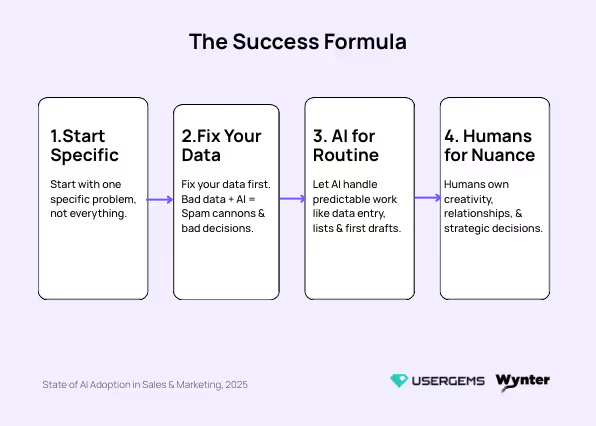

.png)



